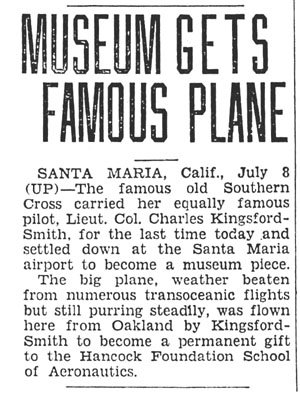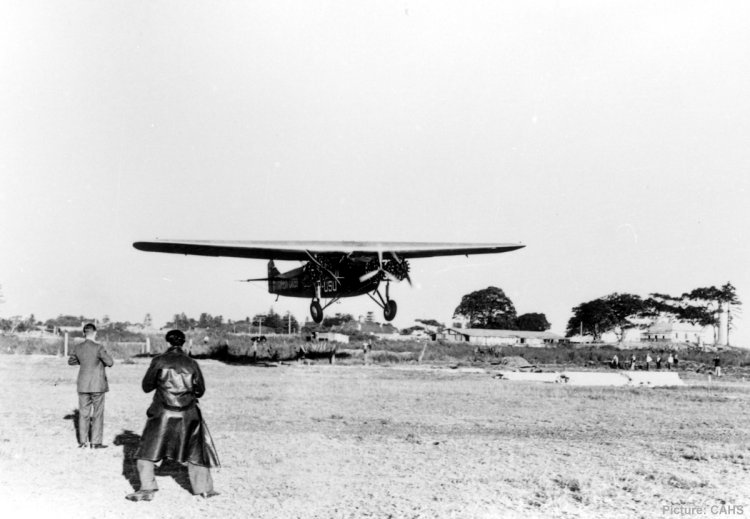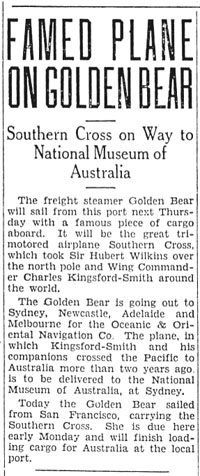|
The retirement
of the Southern Cross got off to a false start on 8 July
1930, less than two years after the epic trans-Pacific flight,
when Smithy flew the aeroplane from Oakland to Santa Maria,
California to return the Southern Cross to Captain G.
Allan Hancock, the generous benefactor who had funded the acquisition
of the aeroplane for the Pacific flight. In those two years,
Smithy had flown the Southern Cross around the world,
finishing up at Oakland from where the first Pacific flight
had begun. The San Pedro News Pilot of 8 July 1930 reported
that the aircraft was to become "a permanent gift to the
Hancock Foundation School of Aeronautics."

San
Pedro News Pilot
8 July 1930
The Los Angeles Daily News of the same date reported
that "a crowd of more than 10,000 persons cheered as the
Southern Cross swooped from the skies for an easy landing
after a flight from Oakland." This publication reported
the recipient institution as the "Hancock Institute of
Aeronautics".
The King City Rustler of 11 July 1930 reported that the
aircraft landed at Santa Maria at 12.15pm on Tuesday 8 July.
Smithy gave a short talk to the assembled spectators, claiming
that he was the only aviator to land in Southern California
with such a heavy load. He went on to explain that the heavy
load was his debt of $16,000 owed to Captain Hancock for funding
the purchase of the Southern Cross. After the speeches,
the aircraft was "wheeled into a shed ... never to take
the air again but to remain upon exhibit at the Hancock Foundation
of College Aeronautics" adding yet another variation of
the name of the new custodian. Some newspapers reported that
the Southern Cross had a black fuselage and silver wings
and Smithy was variously reported as a Wing Commander, Lieutenant
Colonel, Major and Captain.
Although all the contemporary press reports suggested that the
Southern Cross was destined for retirement in a museum,
Ted Wixted described the transaction between Smithy and Captain
Hancock as a more gentlemanly arrangement; "Conscious that Hancock
was the source of his triumphs, he quite properly offered the
Southern Cross back to him. In his turn Captain Hancock
graciously acknowledged the gesture, and insisted that the aircraft
should remain the property of Kingsford Smith. Honour was satisfied."
By the end of 1930 there had been a change of plans. The Lompoc
Review of 16 December 1930 reported; "Hancock to Return
Southern Cross to People of Sydney." It was also revealed
that a deal to preserve the Southern Cross at the Smithsonian
Institution had fallen through. The Southern Cross would
be flown from Santa Maria to San Francisco on Sunday 21 December
to be "knocked down" for shipping to Australia. It
is not recorded who piloted the aircraft but clearly it could
not have been Smithy. On 10 December he was in Melbourne getting
married to Mary Powell!
On 10 January 1931, the San Pedro News Pilot reported
that the S.S. Golden Bear had sailed from San Francisco
on this day with the Southern Cross on board. The ship
would load additional cargo at San Pedro before sailing for
Sydney, Australia on Thursday 15 January.
The San Francisco Examiner reported the departure of
the Southern Cross in most elegant fashion as recorded
in Smithy's biography (Source: 2):
It will take 26 days to cover what those roaring Whirlwind
motors accomplished in 88 hours. There will be no gallant conquest
of the darkness now; no tempestuous storm to encounter, no lashing
gales and no cheering throngs -— just a crowded place in
the hold of a crawling tramp steamer. The dauntless path-finder
that kings and presidents acclaimed -— now a lonely old
crate -— follows its master home.
Thus was set in train a sequence of events that suggest that
while the Southern Cross was universally loved, nobody
wanted to be responsible for it.
|
|
|
|
Lompoc
Review
16 December 1930
|
San
Pedro News Pilot
10 January 1931
|
Contrary
to contemporary press reports, the Southern Cross was
not immediately destined for another museum in Australia. Indeed,
as recorded in his biography, Smithy was "very glad to
have the old bus back at Mascot." After the aircraft arrived
in Sydney it was reassembled and test flown by Smithy on 3 April
1931 and immediately put to work on the search for ANA's Avro
Ten VH-UMF Southern Cloud which had gone missing on 21
March. Sadly the aircraft was not to be found in Smithy's lifetime.
The Southern Cross was to take the place of her lost
sister as an airliner in the A.N.A. fleet.
Later in April, the Southern Cross was again pressed
into service to rescue the England-Australia mail from an Imperial
Airways aircraft that had crashed at Koepang. Indeed it was
anything but retirement for the Southern Cross which
was put to work barnstorming, by providing thousands of Australians
with their first flight with no less a pilot than their idol
Smithy. The aircraft also operated two airmail services across
the Tasman with further barnstorming in New Zealand.
In September and October of 1934, the Southern Cross
was tasked on an arduous geophysical survey of northern Australia
flown by Pat Hall and Harry Purvis.
In May 1935, the Southern Cross was called upon to operate
one more trans-Tasman airmail flight to celebrate the Jubilee
of King George V. While well out over the Tasman Sea, part of
the exhaust manifold of the centre engine carried away, smashing
the propeller of the starboard engine which had to be shut down.
The aircraft managed to return to Sydney but only because of
Smithy's superior flying skills and his empathy with his 'Old
Bus' and because of the bravery of P.G. Taylor who transferred
oil between engines in flight.
With other plans pressing on his mind, Smithy probably concluded
that his 'Old Bus' had done enough and it was finally time for
her to retire for good.

One
can almost sense the exhaustion in the cockpit as the Southern
Cross limps across the fence at Mascot on 16 May 1935 after
the aborted Jubilee Mail flight. The starboard engine is shut
down and the tip of the propeller is splintered.  Picture:
Civil Aviation Historical Society - Len Dobbin Collection Picture:
Civil Aviation Historical Society - Len Dobbin Collection

This
rare item is part of the last commercial payload carried by
the Southern Cross. Although the mail was reluctantly
jettisoned to save the aircraft and its crew, one mail bag containing
this flown cover was overlooked. This cover is signed by John
Stannage, the radio operator on the flight. It carries the additional
inscription; "Saved on Jubilee Flight 1935". Source:
Phil Vabre Collection Source:
Phil Vabre Collection
|







